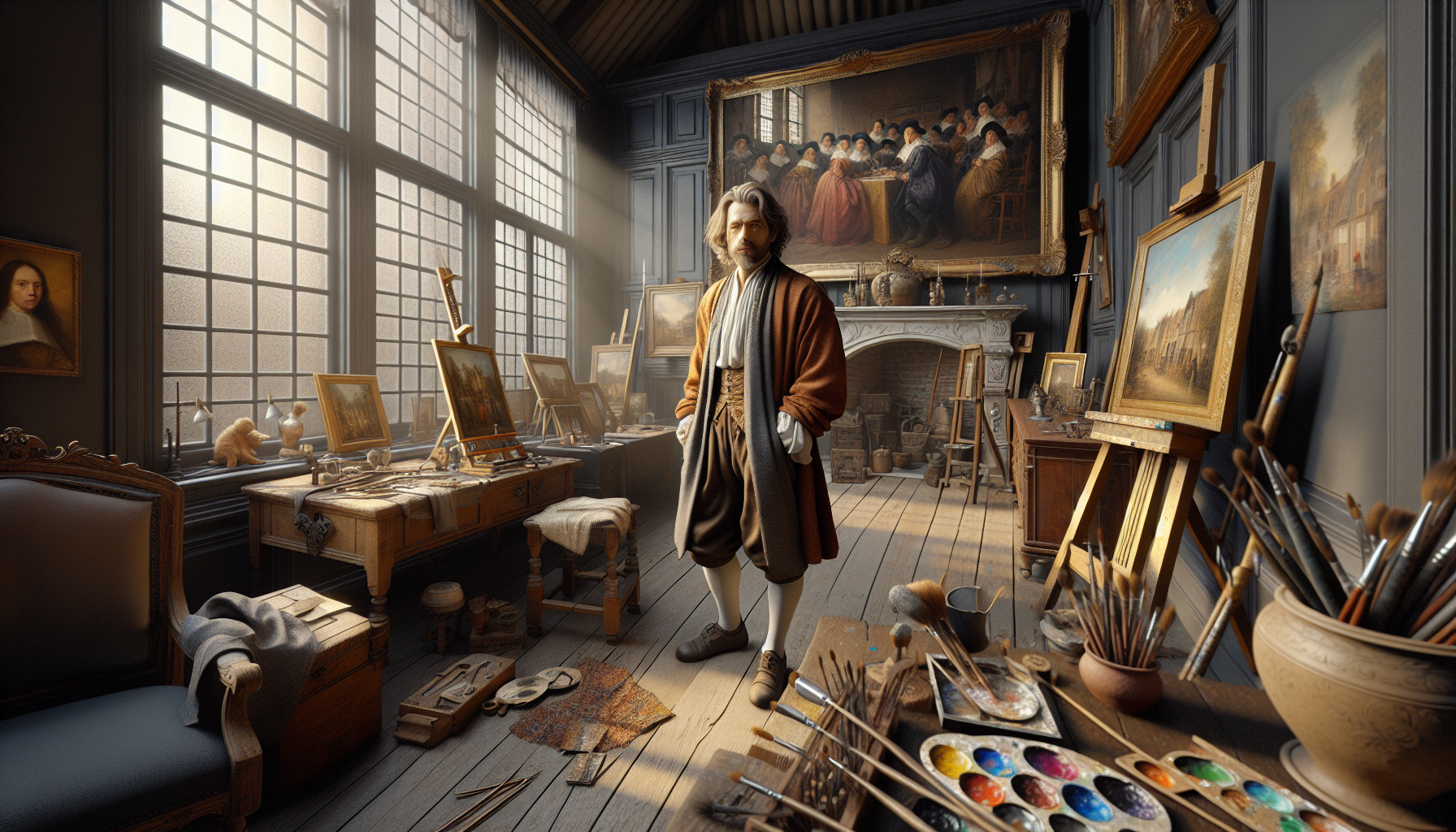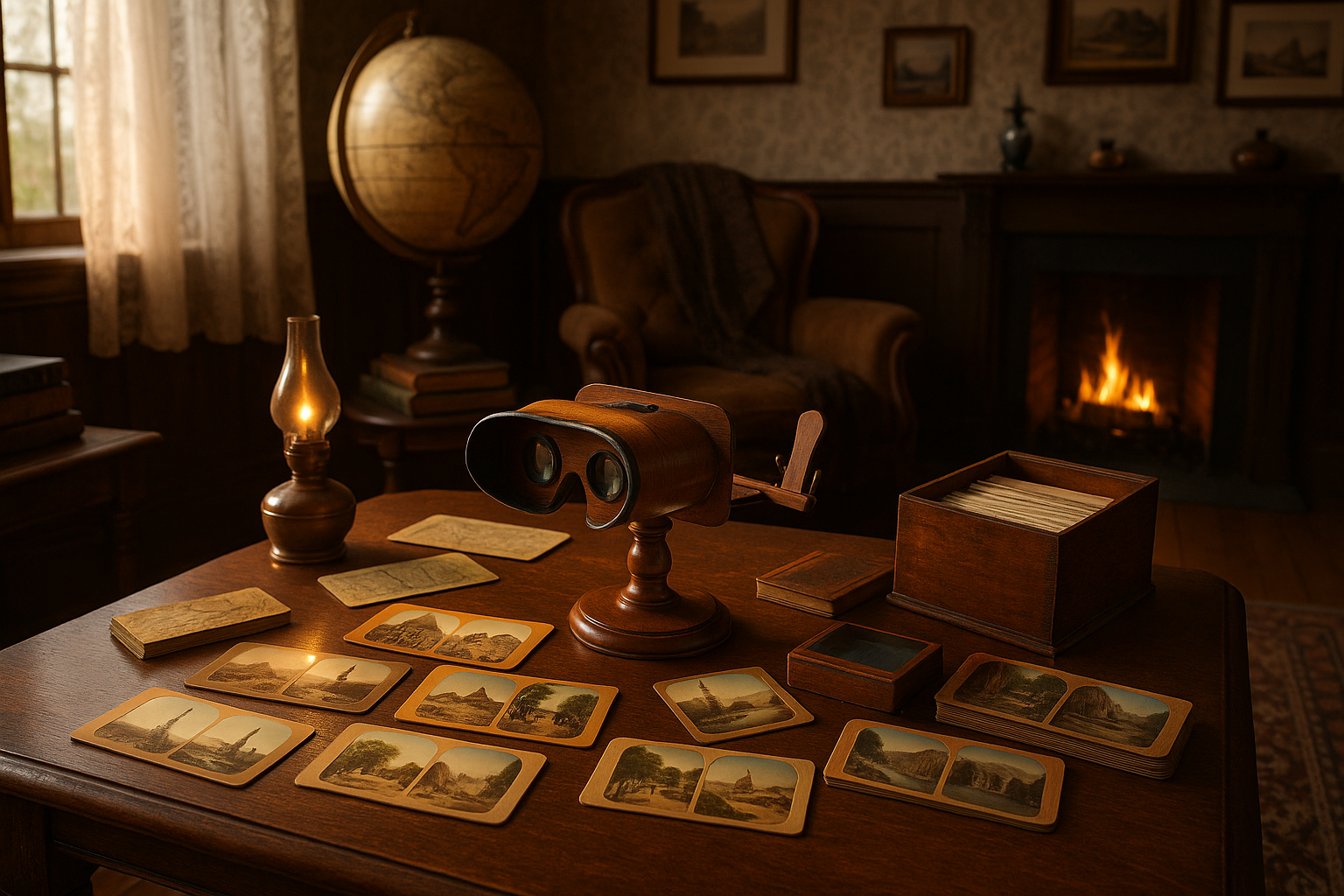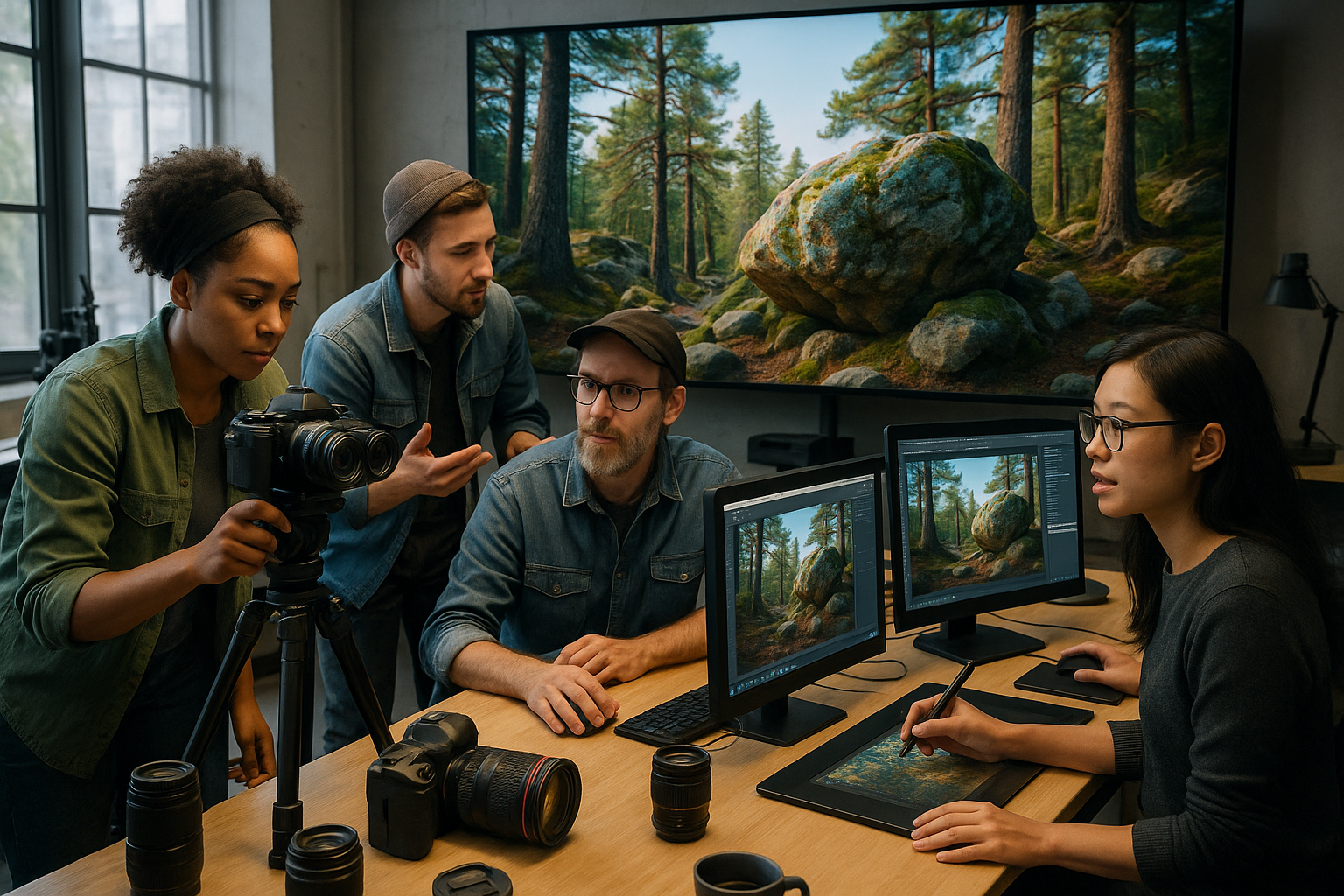In the heart of the 17th century, a remarkable transformation took place in a small corner of Europe that would forever change the landscape of art and culture. The Netherlands, a relatively modest nation in terms of size, emerged as an artistic powerhouse, giving birth to what we now refer to as the Dutch Golden Age. This period was not just a fleeting moment of brilliance, but a seismic shift that influenced artistic standards and techniques, setting a precedent for excellence that resonates to this day. 🎨
Imagine walking through the narrow, winding streets of Amsterdam during this era. The air is filled with the scent of oil paints, and every corner you turn reveals a new canvas, a new story waiting to be told. The Dutch artists of the 17th century were not only creators but innovators, developing techniques that captured the world in unprecedented detail and emotion. Their work was characterized by a mastery of light and shadow, a profound attention to detail, and an ability to convey the subtleties of human emotion and everyday life. These techniques, though centuries old, continue to be revered and studied by artists and historians alike.
The magic of the Dutch Golden Age lies not only in the artworks themselves but also in the innovative methods employed by the artists of the time. From the meticulous layering of glazes to the revolutionary use of perspective, Dutch painters such as Rembrandt, Vermeer, and Frans Hals were pioneers in their field. They brought a fresh perspective to traditional subjects, transforming portraits, still lifes, and landscapes into studies of depth and realism. But how exactly did they achieve such a level of mastery? What can modern artists learn from these techniques to enhance their own work today?
In this exploration of the Dutch Golden Age, we will delve deep into the unique methodologies that set these artists apart. We’ll uncover the secrets behind their use of chiaroscuro to create dramatic contrasts and explore their innovative approaches to color and texture. We’ll also look at how these techniques can be applied in today’s artistic practices, offering insights for both seasoned professionals and aspiring artists. 🖌️ Whether you are a creator seeking inspiration or an art lover eager to understand the intricacies of this golden era, this journey through the past promises to enrich your appreciation of art and its boundless possibilities.
As we navigate this rich tapestry of artistic brilliance, we invite you to immerse yourself in the world of the Dutch masters. Let us unravel the mysteries behind their techniques and celebrate the enduring legacy they have left behind. Join us as we master the golden age and unlock the timeless lessons hidden within the strokes of a brush. This is more than just a history lesson; it is an invitation to see the world through the eyes of the greats and to discover the endless potential of artistic excellence. 🌟
The Rise of Dutch Art in the 17th Century
The 17th century marked an extraordinary period in the history of Dutch art, often referred to as the Dutch Golden Age. This era was characterized by a surge of creativity and innovation that propelled the Netherlands to the forefront of the art world. The socio-economic factors, such as the booming trade industry and the establishment of a prosperous middle class, provided artists with both the means and the audience to explore new artistic frontiers.
The Dutch Republic’s unique political structure, which promoted a high degree of autonomy in cities, also played a significant role. This autonomy led to an environment that encouraged artistic experimentation and the flourishing of new styles and techniques. The era saw the rise of genres that were previously considered secondary, such as still life, landscapes, and genre paintings. The artists of this period developed a keen attention to detail and realism, which became hallmarks of Dutch art.
As the demand for art increased, artists began to specialize in specific genres, leading to a diversification of styles and themes. The Protestant Reformation also influenced Dutch art, steering it away from religious themes towards more secular subjects. This shift was reflective of the broader cultural and religious landscape of the time. Check out the table below to compare some key characteristics of the art in this period:
| Characteristic | 16th Century | 17th Century |
|---|---|---|
| Primary Themes | Religious and Mythological | Secular, Landscapes, Still Life |
| Artistic Focus | Idealization | Realism and Detail |
| Patronage | Church and Nobility | Middle Class |
For a visual overview of this transformative period, I recommend watching this insightful video titled “Dutch Art in the Age of Rembrandt” on the channel ‘The Art Historian’. 🎨
Innovative Techniques and Iconic Artists
The Golden Age of Dutch art was not only defined by its thematic diversity but also by the innovative techniques that artists employed to achieve unprecedented levels of detail and realism. One of the most significant developments was the use of oil paint, which allowed for richer colors and greater flexibility in blending and layering. This enabled artists to create intricate textures and subtle gradations of light and shadow.
Artists like Rembrandt van Rijn mastered the use of chiaroscuro, a technique that uses strong contrasts between light and dark to create a sense of volume and depth. His work exemplifies the power of light in creating mood and emphasizing the emotional intensity of his subjects. Other artists, such as Johannes Vermeer, were renowned for their meticulous attention to detail and the use of perspective to create realistic interior scenes.
The table below highlights some of the most influential artists of the Dutch Golden Age and their contributions to art:
| Artist | Key Contributions | Notable Works |
|---|---|---|
| Rembrandt van Rijn | Master of Light and Shadow | The Night Watch, The Anatomy Lesson of Dr. Nicolaes Tulp |
| Johannes Vermeer | Use of Light and Interior Scenes | Girl with a Pearl Earring, The Milkmaid |
| Frans Hals | Lively Portraits | The Laughing Cavalier, Malle Babbe |
As you delve deeper into the techniques of these artists, consider exploring the impact of their work on contemporary art practices. Watch the following video for an in-depth analysis of Rembrandt’s influence on modern painters. [Link to a YouTube video about Rembrandt’s techniques]
Chiaroscuro: The Play of Light and Shadow
The technique of chiaroscuro was revolutionary in the way it transformed two-dimensional paintings into dynamic and lifelike scenes. This play of light and shadow was not merely a technical achievement but a narrative device that artists like Rembrandt used to evoke emotion and convey deeper meaning. His paintings often featured figures emerging from darkness, bathed in a soft glow that highlighted their expressions and gestures, adding a dramatic intensity to the composition.
This technique was not solely about contrast but about the careful modulation of light, allowing for a range of tones that conveyed the subtleties of texture and form. The skillful use of chiaroscuro became a defining feature of the Baroque style, influencing artists across Europe.
To see chiaroscuro in action, I invite you to watch a video demonstration on how modern artists can replicate this technique using digital tools, bridging the gap between traditional and contemporary art forms.
Impact on Modern Art
The legacy of Dutch Golden Age art extends far beyond the 17th century. Its influence can be seen in various art movements and continues to inspire artists today. The emphasis on realism and attention to detail set a standard for future generations, while the innovative techniques pioneered by artists like Rembrandt and Vermeer laid the groundwork for modern artistic practices.
In the realm of portraiture, the dynamic compositions and psychological depth that characterized the works of Frans Hals and others have influenced countless artists. The genre of still life, elevated to new heights by Dutch painters, paved the way for later explorations in composition, color, and symbolism.
Modern art movements, such as Impressionism and Realism, drew heavily from the techniques and themes of the Dutch Golden Age. The use of light, color, and perspective were reimagined in new contexts, demonstrating the timeless appeal of these elements. Check out the following list of contemporary artists who have cited Dutch masters as key influences in their work:
- David Hockney
- Lucian Freud
- Gerhard Richter
- Peter Doig
For a deeper understanding of how the Dutch Golden Age continues to shape modern art, explore this fascinating video titled “The Lasting Influence of Dutch Masters on Contemporary Artists” on ‘Art Insights’.
The Dutch Golden Age was a period of unprecedented artistic achievement, characterized by innovation, diversity, and a mastery of techniques that continue to captivate audiences today. Its impact on the art world is profound and enduring, offering endless inspiration for both artists and art enthusiasts alike. 🎨✨

Conclusion
In conclusion, exploring the rich tapestry of Dutch artistic techniques from the 17th century provides not only a historical insight but also a reservoir of inspiration and knowledge for contemporary artists and art enthusiasts. This era, often referred to as the “Golden Age,” was a period where art flourished in the Netherlands, characterized by an extraordinary level of detail, innovative techniques, and a deep exploration of everyday life. By delving into the methods and philosophies of this time, we gain a clearer understanding of how art can be both a reflection of society and a catalyst for cultural development.
Throughout the article, we have highlighted several key techniques that defined this era. The mastery of light and shadow, also known as chiaroscuro, was pivotal in creating depth and realism in paintings. This technique allowed artists to produce a striking contrast that drew viewers into the composition, guiding their focus to the most important elements of the artwork. Artists like Rembrandt are celebrated for their ability to manipulate light to evoke emotion and narrative, a technique that remains influential to this day.
Moreover, the use of perspective was another groundbreaking development. Dutch artists mastered linear perspective, creating an illusion of space that was both convincing and captivating. This approach not only enhanced the realism of their works but also offered a new way of storytelling through art. The careful calculation and placement of vanishing points provided a mathematical precision to their compositions, making scenes appear life-like and relatable.
Another significant aspect discussed is the attention to everyday life and domestic scenes, known as genre painting. This focus on the mundane aspects of life provided a window into the 17th-century Dutch society, showcasing the culture, fashion, and daily activities of the time. Artists such as Vermeer excelled in this genre, their works immortalizing the quiet beauty of ordinary moments. The emphasis on realism and the depiction of contemporary life resonated deeply with viewers, offering a sense of connection and relatability that transcends time.
The meticulous detail and texture achieved through glazing techniques were also a hallmark of Dutch artistry. Layering thin glazes of oil paint allowed artists to build depth and luminosity, giving their works a vibrant and lifelike quality. This technique required patience and precision, demonstrating the dedication of Dutch artists to their craft. The result was paintings that were not only visually stunning but also rich in texture and dimension.
Furthermore, the economic and social context of the Netherlands during the 17th century played a crucial role in shaping the art of the time. The prosperity brought about by trade and commerce provided artists with the means and freedom to experiment and innovate. This period saw a democratization of art, where works were not only commissioned by the wealthy but also accessible to the burgeoning middle class. This shift contributed to the diversity of subjects and styles, allowing art to flourish in a dynamic and evolving society.
The significance of these techniques and their impact on art cannot be overstated. They laid the foundation for future artistic movements and continue to inspire artists around the world. The Dutch Golden Age serves as a testament to the enduring power of art to capture the human experience, transcending cultural and temporal boundaries.
In embracing these historical techniques, modern artists can find a wealth of inspiration and guidance. Whether through the delicate interplay of light and shadow, the precision of perspective, or the celebration of everyday life, these methods offer timeless tools for artistic expression. As we continue to explore and reinterpret these techniques, we keep the spirit of the Dutch Golden Age alive, perpetuating its legacy of artistic excellence.
We encourage you, dear reader, to delve deeper into this fascinating era and explore how these techniques can inform your own creative journey. Whether you are an artist seeking new inspiration, a student of art history, or simply an admirer of beautiful works, there is much to be learned and appreciated from the Dutch masters. Share this knowledge with others, engage in discussions, and perhaps even apply these techniques to your own artistic endeavors.
In doing so, we not only honor the legacy of the Dutch Golden Age but also contribute to the ongoing dialogue of art and its role in society. Art remains a universal language, capable of conveying complex emotions and ideas. By mastering the techniques of the past, we enrich our present and inspire future generations to continue the pursuit of artistic excellence.
For further exploration, consider visiting resources such as the Rijksmuseum’s digital collection Rijksmuseum and the Mauritshuis’s virtual gallery Mauritshuis. These platforms offer a comprehensive look at Dutch masterpieces and provide additional context to the techniques and styles discussed. 🌟
As we conclude this exploration of the Dutch Golden Age, let us carry forward the spirit of innovation, dedication, and passion that defined this remarkable period. Together, we can continue to celebrate and preserve the rich heritage of art, ensuring its vibrant future. 🎨
Toni Santos is a visual historian and artisan whose creative lens is captivated by the forgotten marvels of antique optical devices. Through his thoughtful storytelling, Toni revives the instruments that once transformed light into wonder—camera obscuras, magic lanterns, kaleidoscopes, and other ingenious tools that shaped our earliest visual imaginations.
His journey is rooted in a fascination with how humans have long sought to bend, reflect, and reveal the unseen. Whether tracing the mechanical poetry of 19th-century projectors or illustrating the tactile elegance of early lenses, Toni’s work invites us to see vision itself as an evolving art form.
Blending handcrafted design with historical inquiry, Toni brings to life the material soul of these devices—celebrating not just how they functioned, but what they meant. His creations and curated stories illuminate a world where science, illusion, and beauty were intricately linked through glass and brass.
As the curator of Vizovex, Toni shares detailed studies, reconstructed artifacts, and immersive content that help others rediscover the origins of visual technology and the magic of analog perception.
His work is a tribute to:
The craftsmanship behind early visual instruments
The wonder of seeing through the eyes of another century
The intersection of optics, art, and imagination
Whether you’re a collector, a designer, or someone drawn to the lost poetry of vision, Toni welcomes you into a world where light is a storyteller—one prism, one lens, one forgotten invention at a time.





